
e-mail :

Sequel to Group Theory
As always, we start with reminding the reader about the "Important Remark" near the end of Part III of Group Theory (To see it, click HERE and then go to (end of) Part III ), a Remark concerning the direction of reading products of group elements, like, say, apq. We read such products (from that Remark onwards) from back to front. Thus (with respect to apq) first q, then p, and then a.
Infinite two-dimensional periodic patterns, or Ornaments (sequel)
In the previous document we investigated antisymmetry patterns derivable from a P2gg pattern.
Figure 1. Pattern representing plane group P2gg . In previous as well as in the present document it is chosen as initial pattern from which antisymmetry patterns are derived. The background color of the motifs s.str. (commas) is set to be blue, representing the initial color. The area representing the identity element is indicated by the symbol 1 .

Figure 2. P2gg pattern of Figure 1, with the two generating glide lines (dashed lines) and the generating half-turn (rotation by 1800) (small red solid ellipse) indicated. While the small red ellipse indicates the symmetry element of the half-turn (namely the [location of the] two-fold rotation axis), the area of the pattern marked h represents the group element which is a half-turn about the axis indicated.
An antisymmetry pattern can be derived from the above given initial P2gg pattern by replacing the generating half-turn h by the antisymmetry half-turn e1h , where the antiidentity transformation is again interpreted as the color permutation (Blue Red) (cycle notation) with respect to the background color.

Figure 3. From the identity element (which has the initial color blue [here indicated by green] ) a red (purple) element -- the element e1h -- is generated by applying the antisymmetry half-turn ( The symmetry element of which is indicated by a small blue solid ellipse).
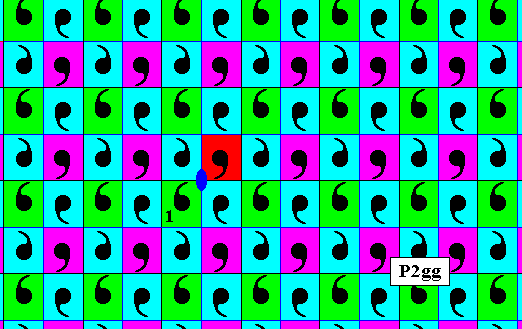
Figure 4. From the two elements 1 and e1h new elements are generated by subjecting them to the generating translations, and the results again to those translations.
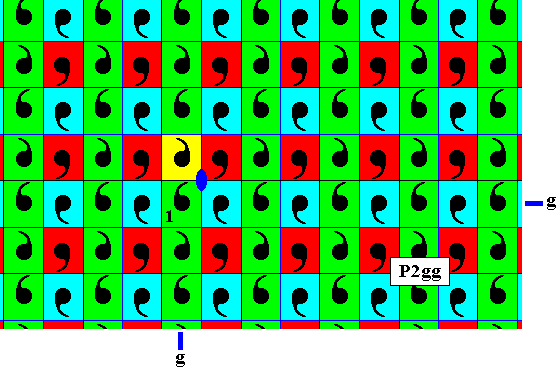
Figure 5. From the identity element another blue (here indicated by yellow) element is generated by one time applying the generating vertical glide reflection in the upward direction.
From this new element other blue (green) elements are generated by the vertical and horizontal translations. The two generating glide reflections (g) are indicated.

Figure 6. From the blue (green) element directly above the identity element a new element is generated, by applying to it the antisymmetry half-turn, that must change color with respect to that blue (green) element (just above the identity element), so its color will be red (purple).
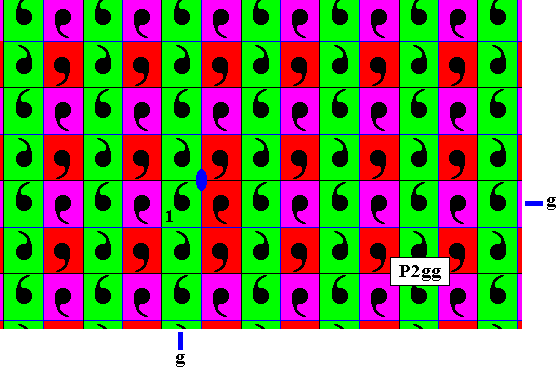
Figure 7. The pattern is completed by applying translations.
Restoring green to blue and purple to red results in the definitive antisymmetry pattern :
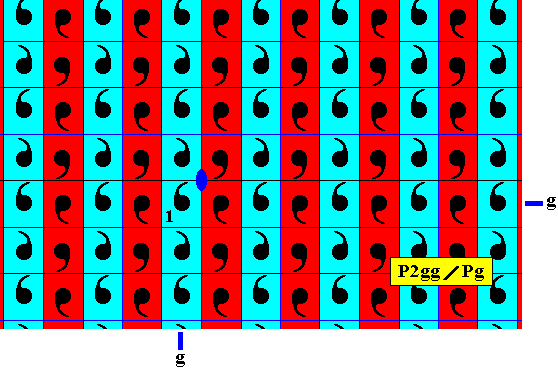
Figure 8. Definitive antisymmetry pattern derived from the generating pattern of Figure 1 by replacing the generating half-turn (blue solid ellipse) by its corresponding antisymmetry transformation (antisymmetry half-turn).
The antisymmetry pattern just obtained is identical to one obtained earlier (See Figure 15 of Part XVII of the present Series ) by replacing the generating horizontal glide reflection by its corresponding antisymmetry transformation.
The pattern of blue elements of the just derived antisymmetry pattern can be generated by subjecting the identity element to the generating vertical glide reflection (which is an element of the full (P2gg) group, yielding the whole column of blue elements containing the identity element, and then subjecting this column to repeated horizontal translation (which is also an element of the full group). So this pattern of blue elements is a subgroup, and its symmetry is according to the plane group Pg (because the horizontal glide reflections and the half-turns are destroyed, resulting in the only symmetries of this pattern to be the horizontal and vertical translations and one type (namely vertical) of glide reflection).
The symbol for the just derived antisymmetry pattern must accordingly read P2gg / Pg .
The next Figures check whether indeed the generating half-turn about the axis indicated involves color change (in virtue of it being replaced by the corresponding antisymmetry half-turn e1h ).
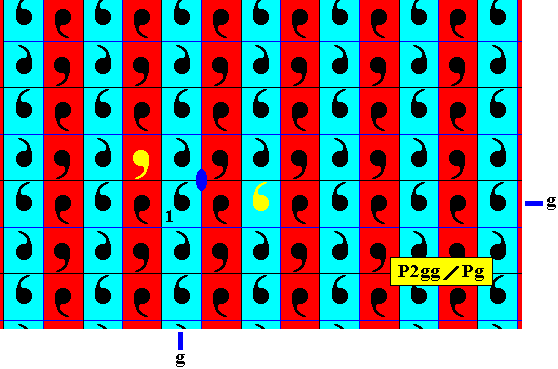
Figure 8.
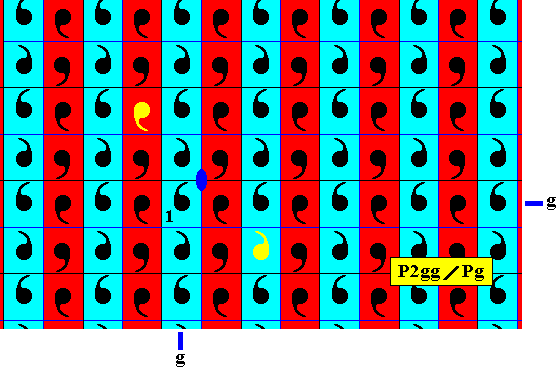
Figure 9.
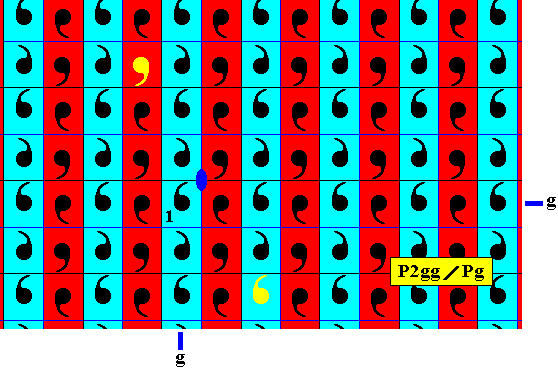
Figure 10.
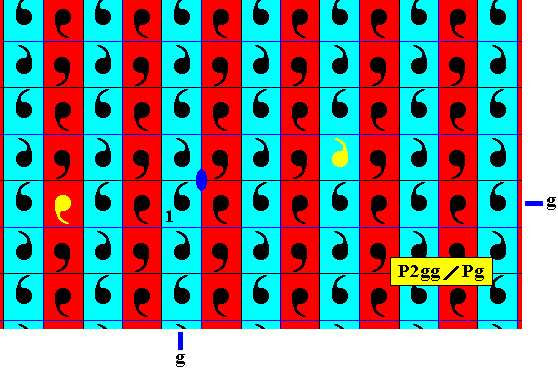
Figure 11.
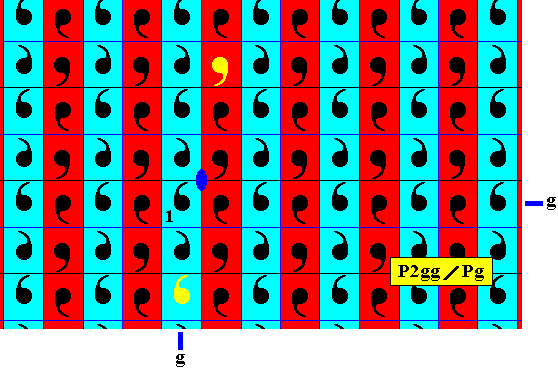
Figure 12.
I do possess only one example of an antisymmetry pattern found in Neolithic art mathematically derivable from a corresponding generating P2gg symmetry pattern.
JABLAN, S., 2002, Symmetry, Ornament and Modularity, p. 145 gives two alleged examples (Fig. 2.108 (e) and (f)), but one of them (e) is not really an antisymmetry pattern derived from a P2gg pattern, but can be derived from a C2mm symmetry pattern (JABLAN uses the short notation pgg for the group P2gg as we denote it).
Figure 13. Generating P2gg pattern from which an antisymmetry pattern found in Neolithic art can be derived by replacing the horizontal generating glide reflection by its corresponding antisymmetry transformation.
Before deriving the antisymmetry pattern we will first analyze the just given generating P2gg pattern.
Figure 14. Unit mesh of the generating P2gg pattern.

Figure 15. Illustration of the equivalence of the four corner points of the unit mesh of the generating P2gg pattern.

Figure 16. Point lattice (indicated by blue connection lines) of the generating P2gg pattern.
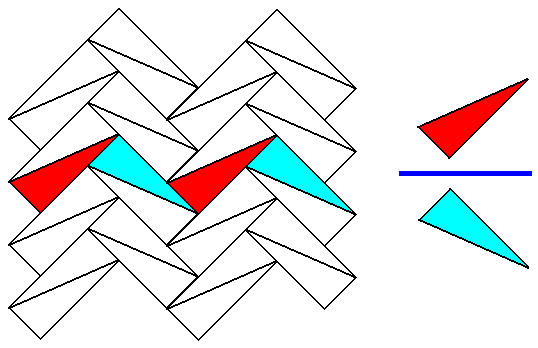
Figure 17. Blow-up of a part of the above given generating P2gg pattern. The red triangles of the pattern are mirror symmetric to the blue triangles (Colors do not signify (anti)symmetry features). See next Figure.
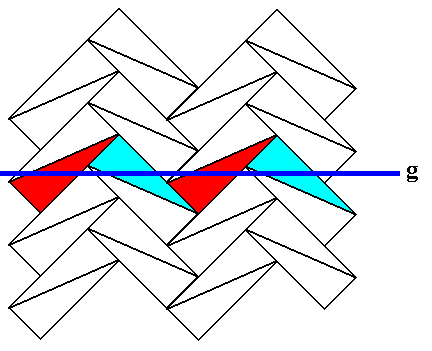
Figure 18. A horizontal glide line (indicated by a solid blue line) of the above generating P2gg pattern.

Figure 19. Illustration of the horizontal glide reflection of the above given generating P2gg pattern.
a is reflected in the glide line (resulting in b) and then shifted along it, resulting in c . Stage b is only intermediary and as such not belonging to the result of the transformation, i.e. a is transformed into c .
On the basis of the foregoing we now know where exactly the horizontal glide lines of our generating P2gg pattern lie. One of them we choose as generating horizontal glide line :

Figure 20. Generating horizontal glide reflection line of the above (Figure 13 ) given generating P2gg pattern.

Figure 21. Illustration of the action of the generating horizontal glide reflection line (glide reflection) gh of the above (Figure 13 ) given generating P2gg pattern. Colors do not signify symmetry features.
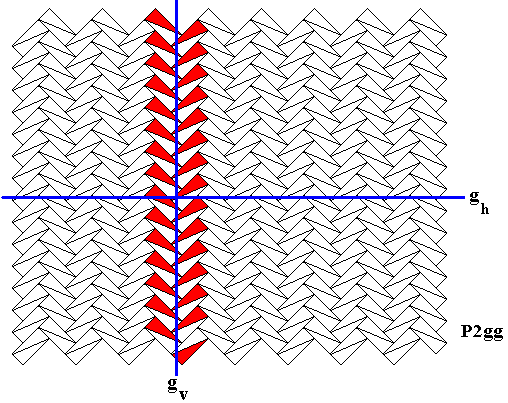
Figure 22. Illustration of the action of a vertical glide reflection line of the above (Figure 13 ) given generating P2gg pattern. We choose this one as to be the generating vertical glide reflection gv . The generating horizontal glide reflection line is also indicated. Colors do not signify symmetry features.
From the above initial pattern (generating symmetry pattern) we can derive an antisymmetry pattern by replacing the horizontal generating glide reflection gh by its corresponding antisymmetry transformation e1gh , where the antiidentity transformation e1 stands for the color permutation (Blue Red) (cycle notation). We will set the color blue as the original color. An odd number of e1's (which reduces to one e1 ) in the symbol of a given group element will change the color of the area that represents this group element from blue to red.

Figure 22a. Action of the (repeated) vertical glide reflection performed on a red and on a blue element. This vertical glide reflection does not effect color change.
When we now apply (repeatedly) the horizontal translation (which is not an antisymmetry transformation) to the elements already generated, we get the whole antisymmetry pattern. Some beginnings of this process are indicated in the next Figure.
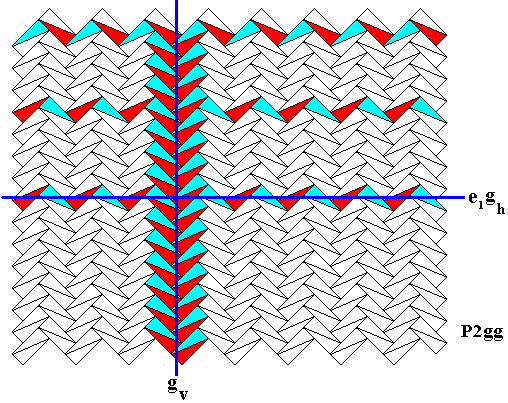
Figure 22b. Illustration of the repeated application of the horizontal translation to the elements already generated earlier.
On the basis of the above we can now give the whole antisymmetry pattern, and after this we give that same antisymmetry pattern in black and white, as it is known from Neolithic art (or as it is depicted in the literature, here in JABLAN, S., 2002).

Figure 23. Antisymmetry pattern (with color alternation Blue -- Red) derived from the generating P2gg pattern of Figure 13 by replacing the generating horizontal glide reflection gh by the horizontal antisymmetry glide reflection e1gh .
This result should be compared with an earlier derivation of this same antisymmetry group (i.e. a derivation involving the same replacement of symmetry transformations by antisymmetry transformations) from a simpler version of the initial P2gg pattern : Figure 15 of Part XVII of the present Series.

Figure 24. A unit mesh of the just derived antisymmetry pattern is indicated.
Its dimensions are the same as that of the generating P2gg pattern (Figure 14 ).
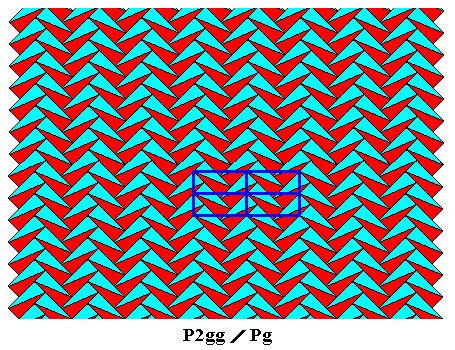
Figure 25. Four unit meshes of the just derived antisymmetry pattern are indicated to show the point lattice.
The next Figure shows the isolated set of blue elements (where we considered blue to be the initial color, and where we consider this set to contain the identity element).
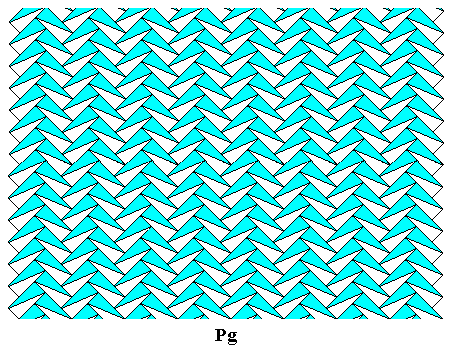
Figure 26. Subpattern of the above derived antisymmetry pattern. This subpattern consists of all the blue elements of the antisymmetry pattern, and is supposed to contain the identity element.
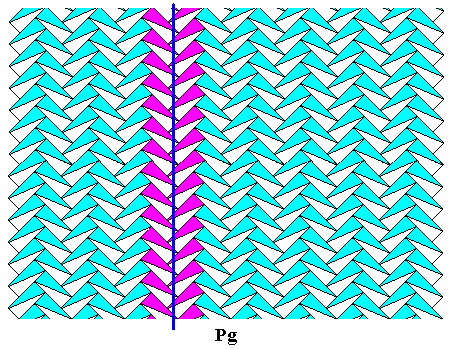
Figure 27. Illustration of the vertical glide line of the subpattern of the above derived antisymmetry pattern.
It is clear that the subpattern of blue elements is periodic, and that its only symmetries are horizontal and vertical translations and vertical glide lines, so its symmetry is that of the plane group Pg . And because the pattern can be generated from the area representing the identity element of the generating P2gg pattern and of the antisymmetry pattern, by applying to it the generating vertical and horizontal translations and the generating vertical glide reflection, which are all elements of the full groups (generating group and antisymmetry group), the pattern of blue areas represents a genuine subgroup of the two mentioned full groups. Consequently the symbol of the antisymmetry group must read : P2gg / Pg .
The next Figure gives the same antisymmetry pattern as was just derived, but now instead of the colors blue and red the colors black and white, as it occurs in Neolithic art.
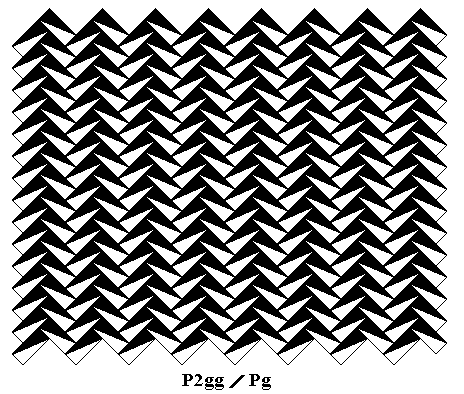
Figure 28. Antisymmetry pattern P2gg / Pg derived from the generating P2gg pattern of Figure 13.
After JABLAN, 2002
Subgroups
We will now discuss some s u b g r o u p s of the plane group P2gg not necessarily associated with antisymmetry or color symmetry. These subgroups are indicated by the color yellow.
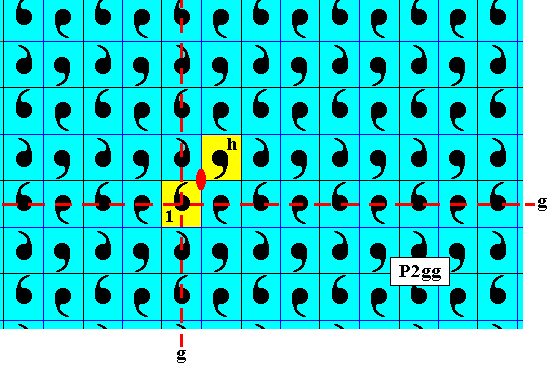
Figure 29. Subgroup C2 (which is a rosette) of the full group P2gg (Figure 1 ), generated by the half-turn about the axis indicated.
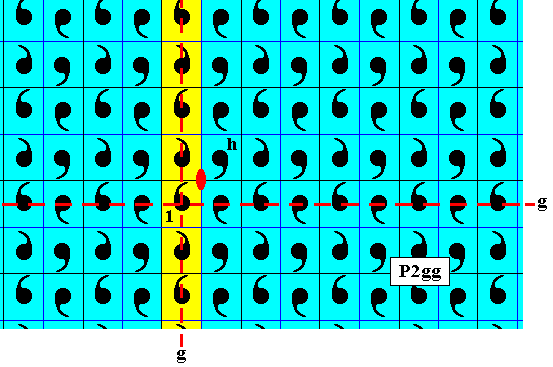
Figure 30. Subgroup p1g (which is a frieze pattern isomorphic to Cinfinity ) of the full group P2gg (Figure 1 ), generated by the generating vertical glide reflection.

Figure 31. Subgroup p1g (which is a frieze pattern isomorphic to Cinfinity ) of the full group P2gg (Figure 1 ), generated by the generating horizontal glide reflection.

Figure 32. Subgroup p11 (which is a frieze pattern isomorphic to Cinfinity ) of the full group P2gg (Figure 1 ), generated by the generating horizontal translation.

Figure 33. Subgroup p11 (which is a frieze pattern isomorphic to Cinfinity ) of the full group P2gg (Figure 1 ), generated by the generating vertical translation.
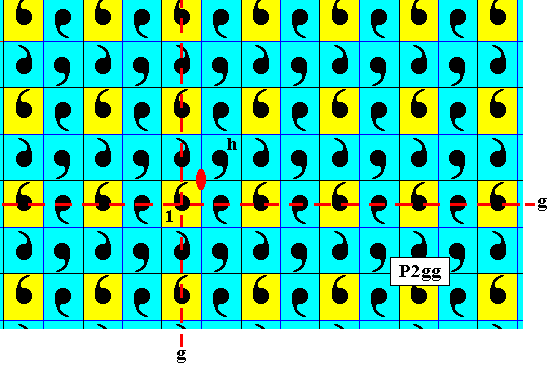
Figure 34. Subgroup P1 (which is a plane pattern isomorphic to Cinfinity x Cinfinity ) of the full group P2gg (Figure 1 ), generated by the generating vertical and horizontal translations.
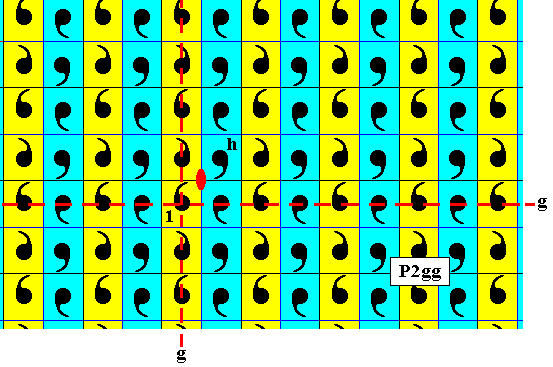
Figure 35. Subgroup Pg (which is a plane pattern isomorphic to Cinfinity x Cinfinity ) of the full group P2gg (Figure 1 ), generated by the generating vertical glide reflection and the horizontal translation.
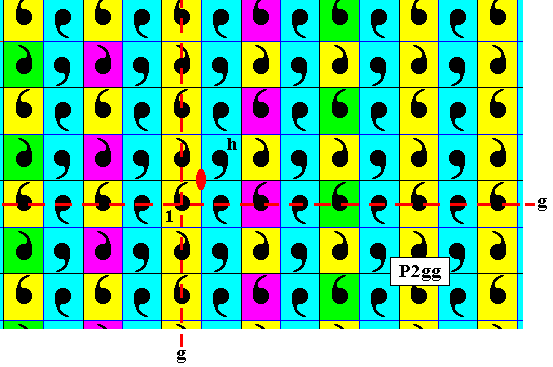
Figure 36. Illustration of the action of the vertical glide line which together with the horizontal translation generates the subgroup Pg of the previous Figure.
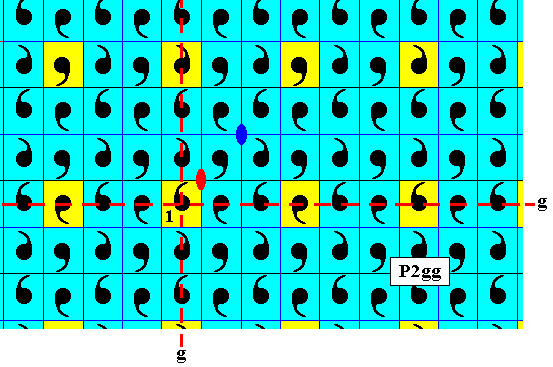
Figure 37. Subgroup P2gg (which is a plane pattern isomorphic to Cinfinity x Cinfinity ) of the full group P2gg (Figure 1 ), generated by the transformations (gh)3 and (gv)3 (which are also elements of the full group).
The generating half-turn (its symmetry element, i.e. its axis, indicated by the red solid ellipse) of the full group is not an element of this subgroup. On the other hand, the half-turn, of which the corresponding symmetry element (axis) is indicated by a blue solid ellipse, is an element of the subgroup, and it can be choosen as one of the generators of the full group.
The next Figure shows that the half-turn (indicated by the blue solid ellipse) -- which is an element of the subgroup -- is also an element of the full group (parent group), namely the element (gv)3(gh)-3 , as it should be.
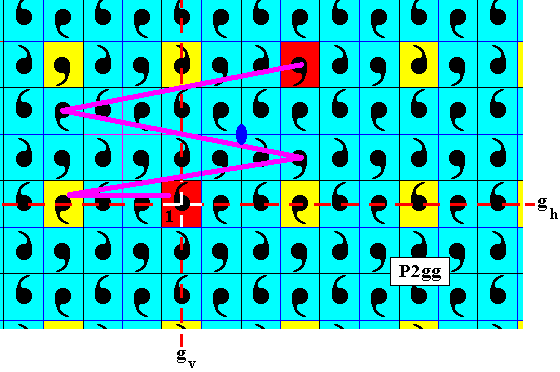
Figure 37a. Subgroup P2gg of the previous Figure. The half-turn indicated by its symmetry element (rotation axis), a blue solid ellipse, is an element of this subgroup, and also an element of the parent group, because it is equivalent to the element (gv)3(gh)-3 , which clearly is an element of the parent group.
The next Figure gives yet another subgroup also having P2gg symmetry.
Figure 38. Subgroup P2gg (which is a plane pattern isomorphic to Cinfinity x Cinfinity ) of the full group P2gg (Figure 1 ), generated by the transformations gh and (gv)3 (which are also elements of the full group).
This subgroup is called H in the discussion below.
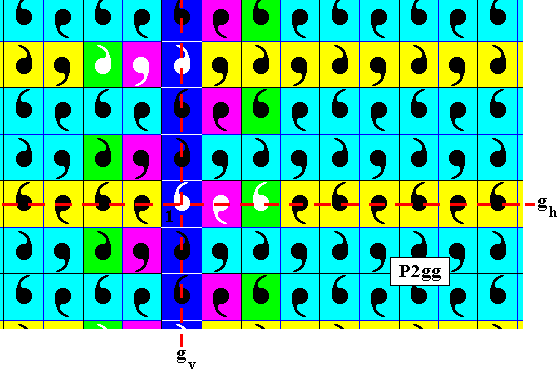
Figure 39. Illustration of the transformation (gv)3 as it is combined with the elements generated (from the identity element) by the transformation gh .
The next Figure extends the pattern as depicted in Figure 38 in order to clearly let stand out the symmetry content of the subgroup.
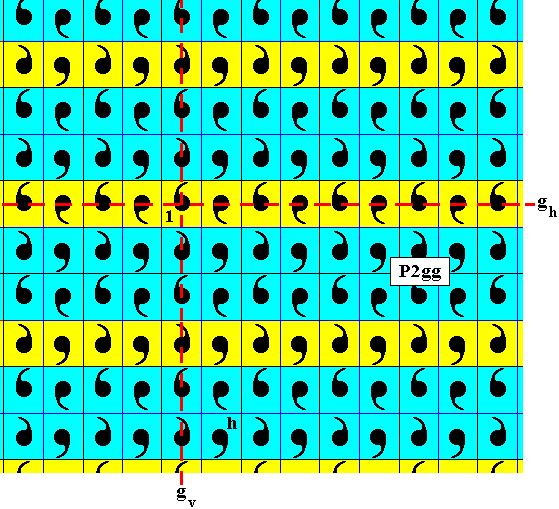
Figure 39a. Extension of the pattern of Figure 38, representing the P2gg parent group and the P2gg subgroup. In the next Figure this subgroup is isolated.
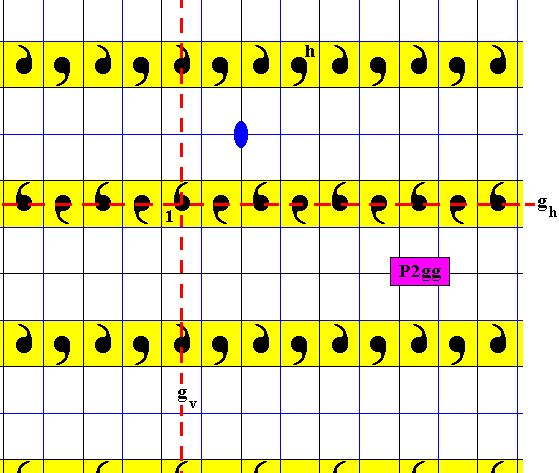
Figure 39b. The subgroup P2gg of the above Figures isolated.
One can clearly see that its symmetries consist of horizontal and vertical glide reflections, horizontal and vertical translations and half-turns. So its symmetry is that of the plane group P2gg , and has, consequently, the same symmetry as its parent pattern.
The just derived subgroup pattern P2gg of the parent group pattern P2gg consists of rows. Which rows? Well every third row of the parent pattern. It has the symmetry of the plane group P2gg (the same as the parent pattern) because it can be generated by repeatedly applying two glide reflections, the glide lines of which are perpendicular to each other.
The next Figure shows the area (originally belonging to the parent pattern) representing the just mentioned element gv .

Figure 39c. The subgroup H .
The area (green) representing the element gv is indicated. This element is not an element of the subgroup, but it is an element of the parent pattern (i.e. the full P2gg group).
For c o s e t s see Part V of the general Series on Group Theory. To see this Part in a separate window click HERE , and after consulting it close the window to return to the present document.
Let us first derive the left coset gvH of the subgroup H by the element gv (generating vertical glide reflection), which means that we first take an element of H and then apply to it the element gv . This we do for every element of H (i.e. for every yellow element in every row). The next Figure shows this for some elements of the subgroup, before giving the final result.
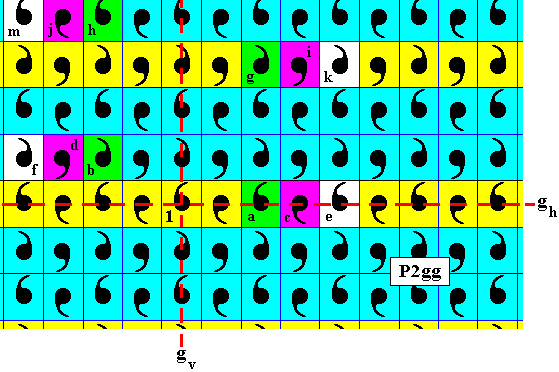
Figure 39d. The subgroup H (yellow) of the full group (yellow + blue).
Generation of the left coset of H by the element gv , illustrated for some elements of H .
From the element a of H the element b (as an element of the left coset of H by the element gv ) is generated.
From the element c of H the element d (as an element of the left coset of H by the element gv ) is generated.
From the element e of H the element f (as an element of the left coset of H by the element gv ) is generated.
From the element g of H the element h (as an element of the left coset of H by the element gv ) is generated.
From the element i of H the element j (as an element of the left coset of H by the element gv ) is generated.
From the element k of H the element m (as an element of the left coset of H by the element gv ) is generated.
If we do this with all the elements of the subgroup H we will obtain its left coset by the element gv . See next Figure.
Figure 40. Left coset (purple colored rows representing (rows of) group elements) of the subgroup P2gg (yellow), which is here called H .
All elements of this coset lie in the rows immediately above the rows of H .
Now we're going to determine the right coset Hgv of the subgroup H also by the element gv , which means that we now first take the element gv , and then apply to it every element of the subgroup H (Recall that a group element of a symmetry group is always a symmetry transformation, i.e. a transformation which leaves the pattern unchanged in appearance).

Figure 40a. Generation of the right coset of the subgroup H ( by the element gv ), demonstrated for a few (areas representing) elements of H .
Element 1 is the identity element, which means the transformation : "do nothing". So if we apply element 1 to the (presupposed) element gv we just are left with this element gv . So this element is our first determined element of the right coset of H .
Element a is in fact the element gh , which means that it is (one time) a horizontal glide reflection along the horizontal dashed line. So if we apply this glide reflection to the presupposed element gv we get the element b (which is in fact the element ghgv ), which is a second element of the right coset of H .
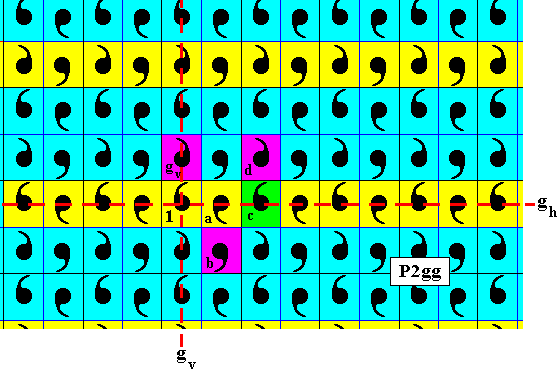
Figure 40b. Generation of the right coset of the subgroup H ( by the element gv ), demonstrated for yet another (area representing an) element of H .
The element c of H is two times the generating horizontal glide reflection along the dashed line, which is equivalent to a translation along that same line. So if we apply this translation to the presupposed element gv we get the element d which is a third element of the right coset of H .
The next Figure does the same with all the elements (of H) lying on the horizontal generating glide line.

Figure 41. First phase in the construction of the right coset of the subgroup H ( by the element gv ).
We successively take an element of the row containing the generating horizontal glide line (and which all are elements of the subgroup H ) and apply it to the element gv [which is supposed to be already given]. The result is a zig-zag pattern of elements (purple).
[For a good understanding of this we can state (i.e. express) the just mentioned performance to be carried out, in a slightly different but equivalent way : We first take the element gv (where "take an element" always means that we apply this element to the identity element which leaves it unchanged) and apply to it successively all the elements of the row containing the generating horizontal glide line].
We now have, so to say, handled one (yellow) row of elements of the subgroup H. The next Figures concentrate on the remaining rows.
The next stage of the construction of the right coset of H goes as follows. We take the element gv and appy to it the transformation (gv)3 which is an element of H belonging to the row of yellow elements above the row containing the horizontal glide line. The result is one more element indicated by the color green :
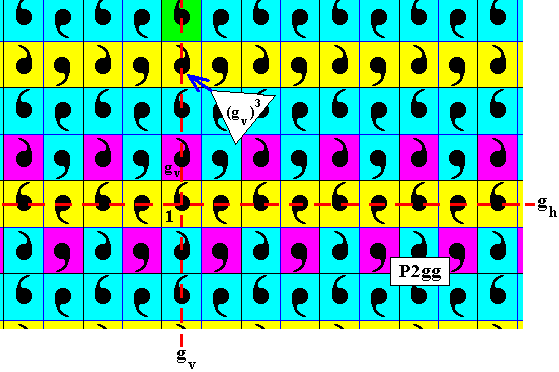
Figure 42. Second stage in the construction of the right coset of the subgroup H . One new element (green) is generated.
What we've just done is applying the yellow element of the upper row in the Figure through which (element) the vertical glide line goes (and which [yellow element] is an element of H ), to the (presupposed) element gv , resulting in the element indicated by the color green.

Figure 42a. Identification of all the elements of the yellow row above the (yellow) row containing the identity element (1) :
The element (gv)3 results from three times applying the transformation gv to the identity element in the upward direction.
All the remaining elements of that (yellow) row have the form (gv)3(gh)k (where k is a non-zero integer), as is shown here for one element, a , which is the element (gh)3 (so here k = 3 , and if we'd taken the yellow element directly to a's right, then k would have been 4 ). The element a ( = (gh)3 ) gives, when subjected to the transformation (gv)3 ( = three times applying the generating vertical glide reflection in the upward direction), the element b ( = (gv)3(gh)3 ) , which is indeed an element of the mentioned yellow row.
And this transformation (gv)3(gh)k must be applied to the presupposed element gv , in order to generate elements of our right coset (of H). So we take the element gv , apply to it successively (i.e. for all values of k ) a horizontal glide reflection according to the glide line indicated in the Figure followed by three times the vertical glide reflection along the glide line also indicated in the Figure :

Figure 43. Third stage in the construction of the right coset of the subgroup H . One new element (green) is generated. The green arrow indicates one time applying the horizontal generating glide reflection (in the direction to the right) to the presupposed element gv . The three blue arrows indicate that the result is now subjected to three times the vertical generating glide reflection (in the upward direction).
In fact we have applied the element x (which is gv3gh ) of H to the presupposed element gv , resulting in the element y (green).
In the next Figure we show the generation of one more element of the coset.
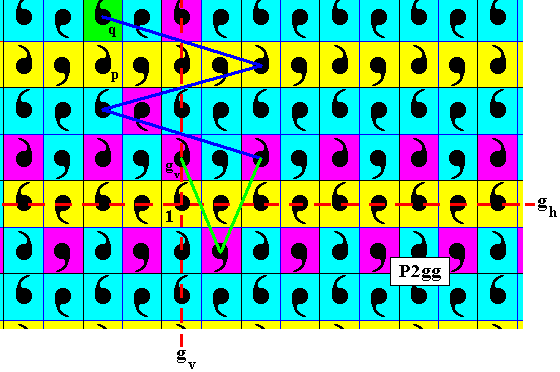
Figure 44. Fourth stage in the construction of the right coset of the subgroup H . One new element (green) is generated. The green lines indicate two times (i.e. k = 2) the application of the horizontal generating glide reflection to the presupposed element gv , while the three blue arrows indicate the application of three times the vertical generating glide reflection to the result.
In fact we have applied the element p (which is gv3gh2 ) of H to the presupposed element gv , resulting in the element q (green).
In the same way we can generate further new elements of this coset by applying the remaining elements of this yellow row to the presupposed element gv , and, finally do the same with respect to all other yellow rows :.
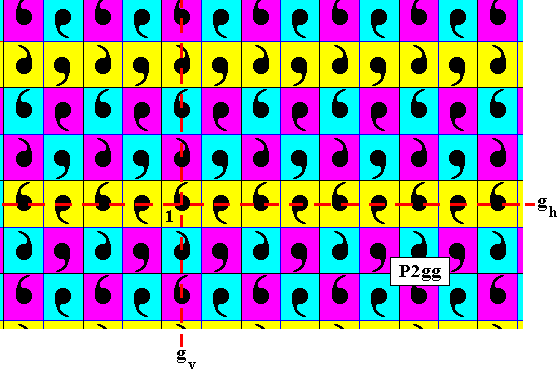
Figure 45. Fifth and final stage in the construction of the right coset of the subgroup H (by the element gv ). The coset consists of the purple elements.
As one can see, this right coset is different from the corresponding left coset (Figure 40 ), which means that the subgroup H of the parent group P2gg is -- in spite of the fact that this subgroup has the same symmetry as the parent group -- not a normal subgroup.
This concludes our exposition of the Plane Group P2gg with respect to antisymmetry, subpatterns and subgroups.
In the next document we will investigate the plane group Cm with respect to antisymmetry, subpatterns and subgroups.
e-mail :

To continue click HERE for further group theoretic preparation to the study of the structure of three-dimensional crystals (crystallography) and the basic symmetry of organisms (promorphology).
Back to 3-dimensional crystals (conclusion), Organic Tectology and Promorphology
Back to subpatterns and subgroups (introduction)
Back to subpatterns and subgroups Part II
Back to subpatterns and subgroups Part III
Back to subpatterns and subgroups Part IV
Back to subpatterns and subgroups Part V
Back to subpatterns and subgroups Part VI
Back to subpatterns and subgroups Part VII
Back to subpatterns and subgroups Part VIII
Back to subpatterns and subgroups Part IX
Back to subpatterns and subgroups Part X
Back to subpatterns and subgroups Part XI
Back to subpatterns and subgroups Part XII
Back to subpatterns and subgroups Part XIII
Back to subpatterns and subgroups Part XIV
Back to subpatterns and subgroups Part XV
Back to subpatterns and subgroups Part XVI
Back to subpatterns and subgroups Part XVII
Back to subpatterns and subgroups Part XVIII
Back to subpatterns and subgroups Part XIX